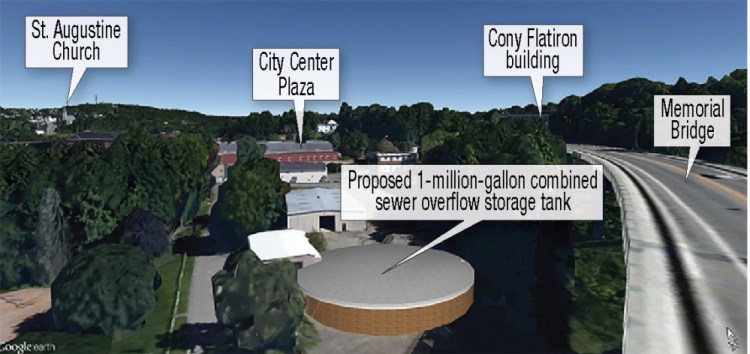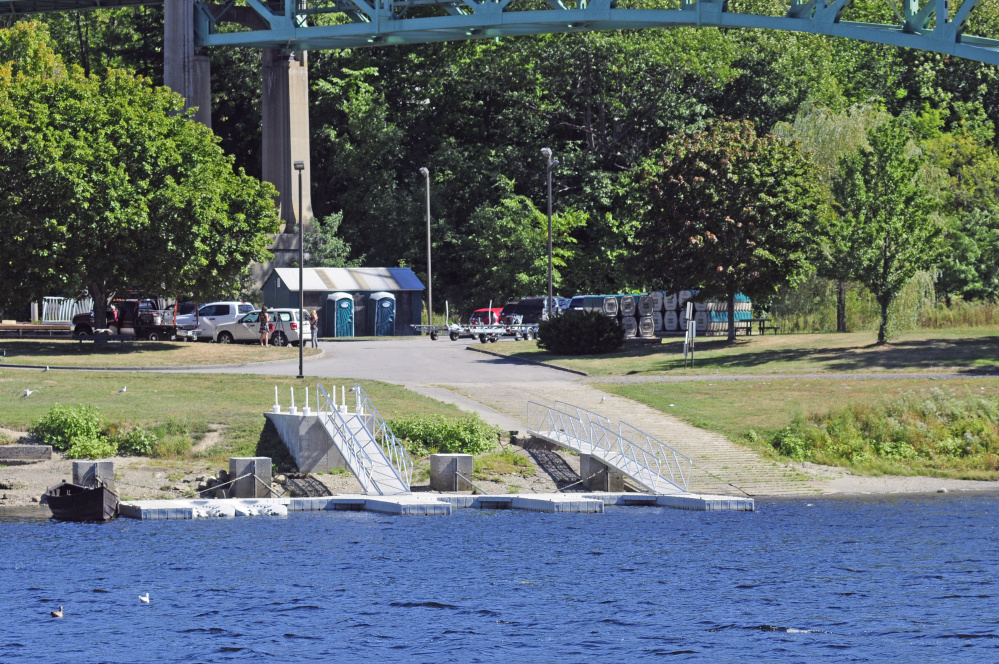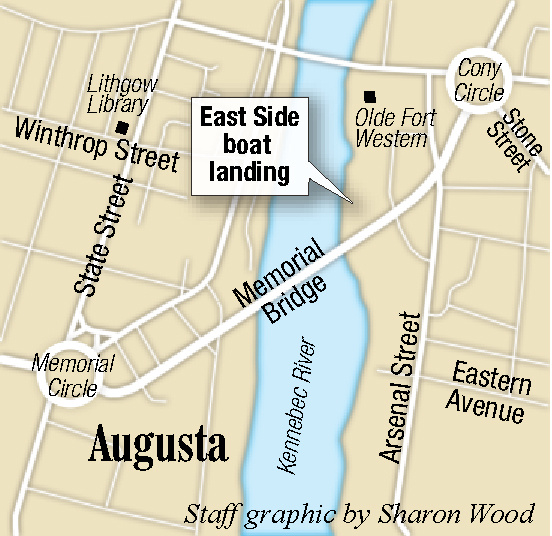AUGUSTA — Greater Augusta Utility District’s proposed new 1-million-gallon combined sewer overflow storage tank is now planned to largely be built underground and rise no higher than 17 feet on Augusta’s riverfront.
City officials previously expressed concerns about the visual impact of the proposed addition of the large concrete tank just behind the city’s East Side Boat Landing on the Kennebec River, an area easily visible from the downtown area directly across the river.
As the design has been finalized district officials now say the tank will have no more than 17 feet of wall visible from the river side of the site, and the up-hill side, facing Augusta City Center, will mostly be underground, other than the tank’s domed roof.
Brian Tarbuck, superintendent of the utilities district, said the dome of the proposed new tank will be about as high as the roof of an existing metal building now on the spot where the tank will be located, on the river side of the site. That building will be removed to make way for the planned new tank.
He said people who’ve seen renderings of the tank have generally be pleased that its visual impact isn’t likely to be as significant as they first worried.
“Overall it presented better than even we thought it would, so that was a nice surprise,” Tarbuck said of design plans.
The $1 million project would add the 100-foot diameter storage tank to hold up to 1 million gallons of stormwater and sewage as part of ongoing efforts to prevent combined sewer overflows into the river during major rainstorms.
“I think a lot of people thought it’d be like a giant steel tank or something you might see in New Jersey,” Tarbuck said. “When you see it tucked into the ground, not as this imposing metal edifice, it’s a little easier to digest.”
The district has put together a digital rendering of what the proposed tank could look like, including a video meant to show what the site would look like, with the tank on it, from multiple perspectives including from above and below the building site, and from across the river.
Mayor David Rollins, upon seeing the digital renderings, was impressed.
“Based on the rendition we’ve seen, I think it is a fabulous job minimizing the impact on sight-lines, including from across the river,” Rollins said. “I can’t imagine there would be objections to that, from citizens, especially with so much of it underground. I think everybody will be excited, as we were concerned when we first heard the tank was going to be above ground.”
City officials learned, and became concerned about, the proposed new tank after a district official approached the city to ask about setback requirements for such a structure.
City officials, at an October meeting with utility district leaders, asked that the design be done with the visual impact of such a large structure in mind.
They noted the tank, if not done with aesthetics in mind, could have a negative impact on the view of the riverfront from across the river in the city’s downtown, where years of revitalization efforts remain underway.
Hall said he has spoken with Professor Eric Stark, who coordinates the architecture program at the University of Maine at Augusta, about students in the program possibly proposing design enhancements for the tank.
“We’re hoping we get a design that sort of enhances the look of the tank itself,” Hall said. “There will still be some visibility (of the tank) especially from the upper floors of downtown residents. So we want to make sure it’s not an obstruction. We appreciate the fact Greater Augusta Utility District is involving us to the extent they have been.”
Tarbuck said if UMA architecture students come up with a better look for the tank, the district is open to considering incorporating changes into the design.
But they had better act quickly, as the district hopes to have the tank built in 2018.
He said the district is also open to the possibility of a mural being painted on the tank and would welcome design ideas to help the tank blend in, but said the district’s main priority remains that the tank be functional and able to collect combined sewer overflow to prevent it from getting into the river.
“We’re engineers, not artists,” Tarbuck said.
Now, the design of the tank involves putting brick siding around the outside of it. Tarbuck said district trustees wanted to see it with bricks because many of the other structures in the immediate area are brick.
Tarbuck said they’re not committed to brick and pretty much any siding material desired could be put on the tank, which will be made of steel-reinforced concrete panels on which siding could be placed. He doesn’t anticipate putting siding on the structure would add significantly to the cost.
The tank would be on district property next to its office and garage facilities between Arsenal, Williams and Howard streets, just behind the city’s East Side Boat Landing.
Tarbuck said the district would borrow the roughly $1 million needed to build the tank. He said the tank appears to be the most affordable way for the district to be able to come into compliance with state Department of Environmental Protection requirements that the district prevent discharges of sewer. Discharges can take place during major rainstorms when stormwater infiltrates the sewer treatment system and overwhelms its ability to treat the combined flow.
Tarbuck said other possible solutions to the problem could cost upwards of $4 million.
Overflow during heavy rainstorms would be caught and fed into the tank where it would be stored. Once the storm subsides, the combined sewage and water would be released from the tank and sent to the treatment plant where it would be treated.
The proposal is the district’s latest step in an ongoing, multi-million-dollar effort to install systems to prevent the overflow of sewage into the river during major rainstorms.
In a $15 million project in 2012 and 2013, the utilities district installed two massive, 670-foot-long storage tanks under Mill Park to collect combined sewer overflow on the west side of the river. The district also has another underground storage tank under a portion of the Kennebec River Rail Trail. The proposed new tank would be the last major piece of infrastructure needed to prevent most overflows and be in compliance with state Department of Environmental Protection requirements regarding overflows.
Keith Edwards — 621-5647
Send questions/comments to the editors.







Success. Please wait for the page to reload. If the page does not reload within 5 seconds, please refresh the page.
Enter your email and password to access comments.
Hi, to comment on stories you must . This profile is in addition to your subscription and website login.
Already have a commenting profile? .
Invalid username/password.
Please check your email to confirm and complete your registration.
Only subscribers are eligible to post comments. Please subscribe or login first for digital access. Here’s why.
Use the form below to reset your password. When you've submitted your account email, we will send an email with a reset code.